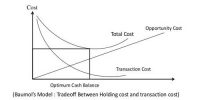Retained earnings refer to the portion of net income (or loss) that is retained by a company rather than distributed to its owners as dividends. It is a business generates earnings which can be positive (profits) or negative (losses). Retained earnings and losses are cumulative from year to year, with losses offsetting earnings. Retained earnings can be expressed as a ratio known as the “retention rate.”
The formula for ending retained earnings is:
Beginning retained earnings + Profits/losses – Dividends = Ending retained earnings
A negative amount of retained earnings is reported as a deficit or accumulated deficit. Common stock is a security that represents ownership in a corporation. Holders of common stock exercise control by electing a board of directors and voting on corporate policy.
The retention rate also can be expressed in terms of the dividend payout ratio:
The reason for the cost of new common stock is higher than the cost of retained earnings –
- When a company issues new common stock they have to pay flotation costs to the underwriter
- Issuing new common stock may send a negative signal to the capital markets, which may depress the stock price.
Retained earnings are the portion of a business’s profits that are not distributed as dividends to shareholders but instead are reserved for reinvestment back into the business. They are reported on the balance sheet under the shareholder’s equity section at the end of each accounting period. They are also called earned surplus, retained capital, or accumulated earnings.














